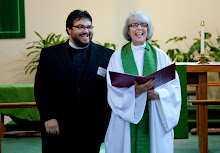Many have used the expression "smells and bells" to generically describe high liturgical forms of worship. However, there is a lot implied in this little phrase.
First is the implication that more than one sense in involved in worship. Indeed we worship with our voices, we see worship with our eyes, we taste the sacrament, we hear the sermon and the music, and with incense we can engage another sense. No harm in engaging our whole being; besides, are we not called to serve God with our whole being, and does that not mean worshiping God with all our senses?
Secondly, the use of incense has been historically used to denote the sacred. Preceding the cross in processions is common as well as incense's use to sanctify the altar, the people and the worship leaders. It is often used in blessings of homes, objects, and people.
Why then do we not see more incense in worship? Perhaps some people are afraid to use incense because it might bother some people; breathing or smelling the smoke might be too much for some. This is a serious concern, but only one. I think quite frankly that most people have this impression of incense but not have firsthand experience. A simple example it to hang a censor on a stand in the chancel – do not even light it or burn anything in it. There often is a noticeable increase in coughing – the ultimate placebo effect. Heaven forbid someone say something about it, you can always say "I didn't even burn anything!"
